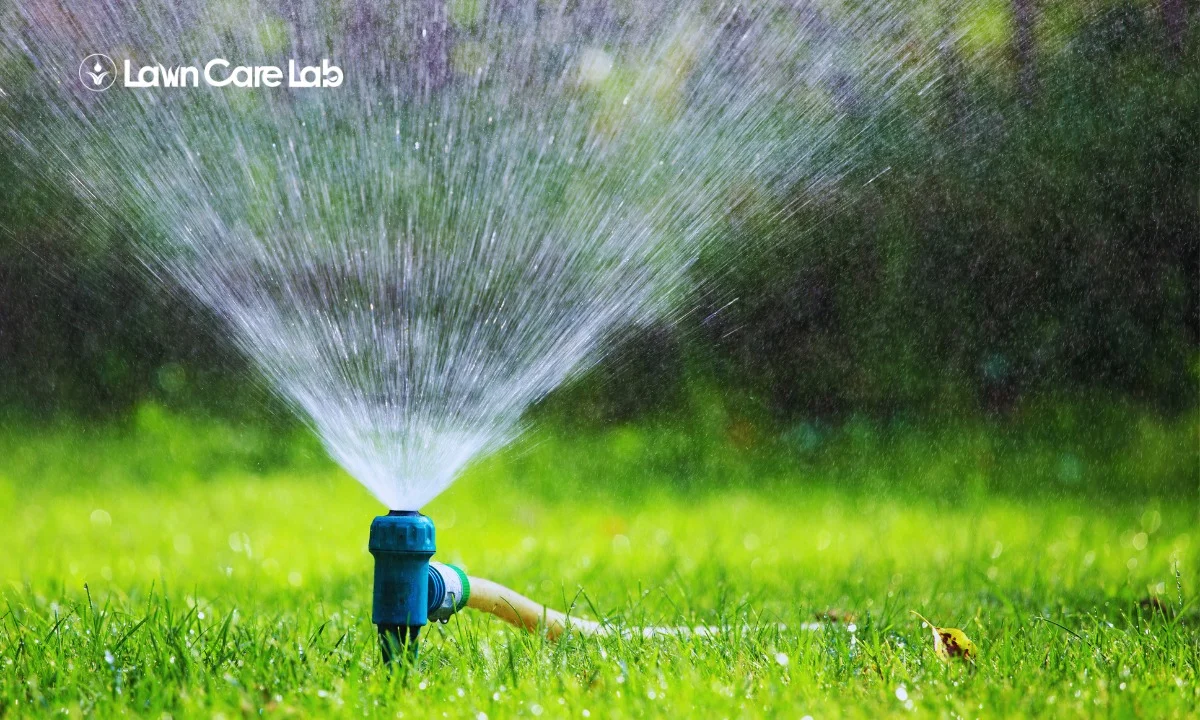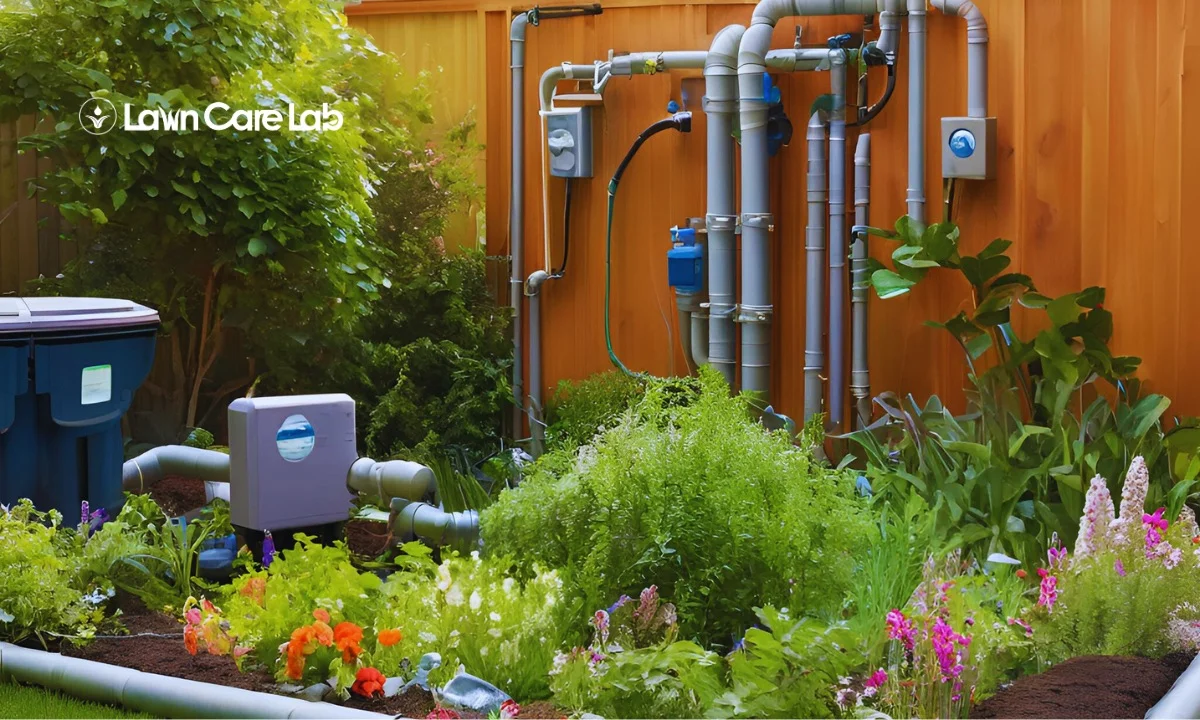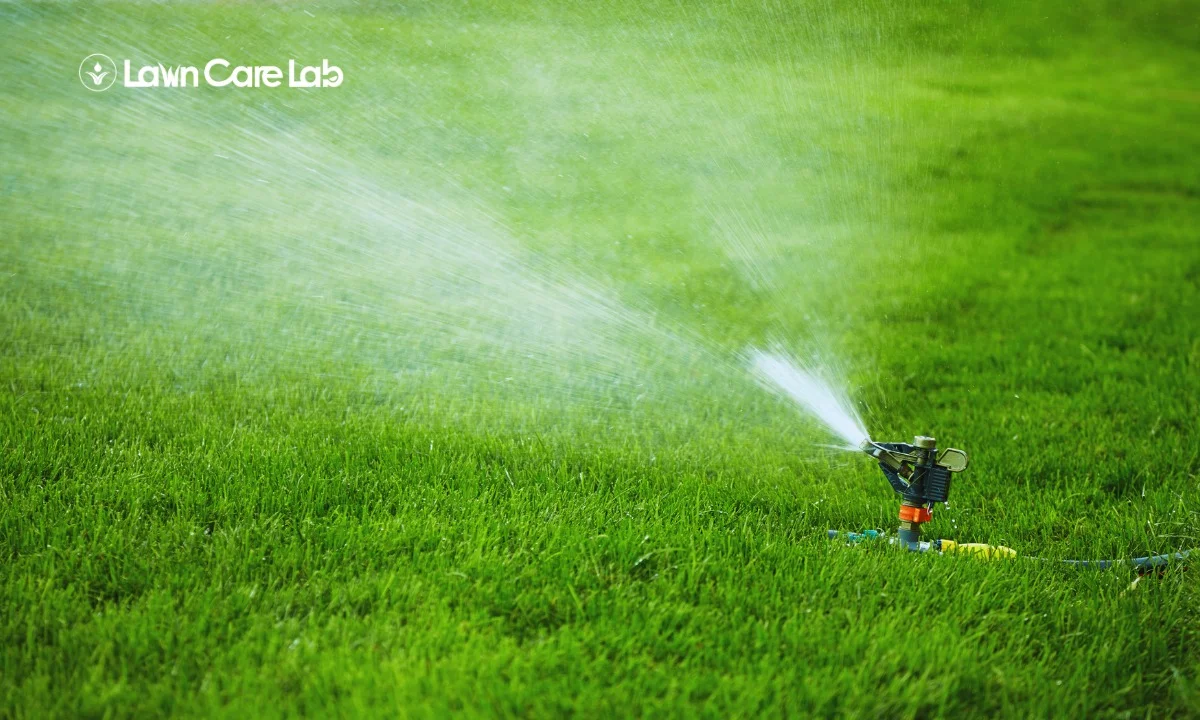Feeling frustrated by a lackluster lawn? It’s high time to become proficient in lawn care! Your watering schedule is pivotal, and the process is far from uniform. Each season brings unique requirements.
Fear not, we have the information you need. This seasonal lawn hydration guide will navigate you from the awakening of spring to the slumber of winter, equipping you with the skills to maintain a thriving lawn throughout the year.
Ready to embark on this journey? Let’s begin.
Table of Contents
Understanding the Importance of Seasonal Lawn Hydration
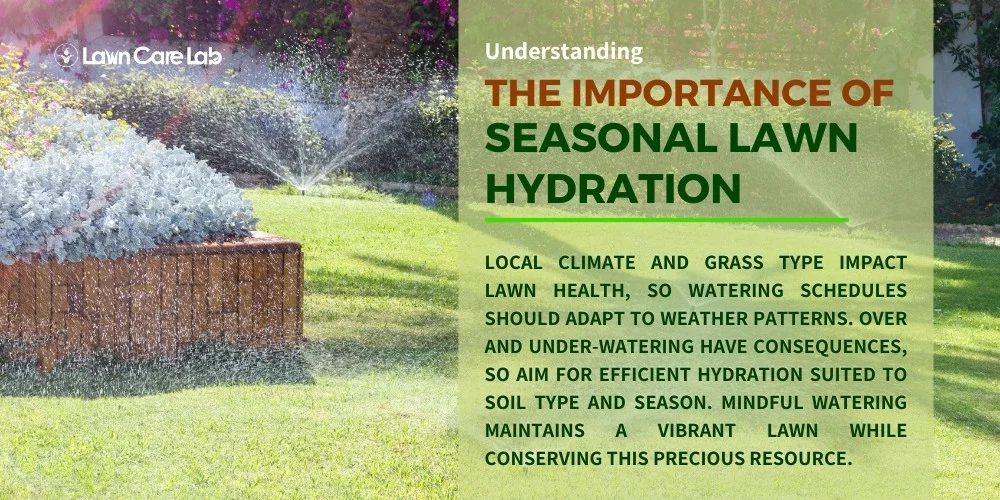
Proper watering is essential for a healthy lawn. Weather changes affect lawn health, so adapting your watering habits is important.
Let’s explore the significance of seasonal lawn watering and suggest ways to conserve water without compromising your yard’s beauty.
The Role of Climate in Lawn Health
Local climate impacts lawn health. Weather patterns and grass type affect growth, color, and well-being. Warm, arid areas suit Bermuda or Zoysia. Cooler climates suit Kentucky Bluegrass or Fescue.
Soil type affects watering needs. Sandy soil needs more watering due to rapid drainage, while clay soil needs less due to water retention. Understanding this helps make informed irrigation decisions, keeping your lawn healthy and vibrant throughout the year.
Water Conservation and Efficient Lawn Care
Knowing your soil and weather is key for water conservation and healthy landscapes. Over-watering causes root decay, while under-watering makes plants prone to pests and infections.
Adjust your watering schedule according to the season to maintain a healthy lawn. Water your lawn early in the morning during hot weather to prevent water loss from evaporation and reduce watering frequency during colder seasons.
Don’t overwater your lawn! Be mindful of its needs and water it wisely to keep it healthy and green while conserving water.
Spring Lawn Watering Tips

As spring unfolds, it’s crucial to fine-tune your lawn irrigation practices to accommodate the shifting season.
A meticulous evaluation of your lawn’s hydration requirements is indispensable, taking into account elements such as temperature fluctuations and precipitation levels.
Armed with this knowledge, you can devise a spring irrigation plan primed to nurture your lawn during the forthcoming sun-drenched months.
Assessing Lawn Water Needs in Spring
In spring, adjust watering to match the lawn’s needs. Analyze soil’s water retention and drainage. Monitor for over/under watering.
Bear in mind the vitality of your lawn is contingent on your aptitude for accurately discerning and satisfying its hydration needs.
Checking for Water Retention and Drainage
To maintain the vitality of your lawn throughout the changing seasons, it’s vital to assess its water retention and drainage consistently.
Regularly observe for signs of water-saturated sections or parched areas.
Employ a soil probe or screwdriver to gauge the soil’s moisture content.
Amend your irrigation routine in response to these observations to prevent the detrimental effects of root decay or desiccation of grass.
A well-nurtured lawn offers a secure and enjoyable space for your family.
Identifying Signs of Overwatering or Underwatering
Identifying the symptoms of excessive or insufficient watering is vital to sustaining a verdant and healthy garden. Should your lawn feel marshy with the grass exhibiting a yellow hue, you’re likely dispensing too much water.
On the contrary, if the grass is manifesting a withered, brown appearance, it’s most likely parched. Rebalance your watering routine to guarantee your lawn’s continued vibrancy and lushness.
Implementing a Spring Watering Schedule
Having evaluated your lawn’s hydration requirements, it’s now crucial to establish an effective spring watering routine.
This includes identifying the ideal watering time and configuring the frequency and duration that aligns with your lawn’s specific needs.
Bear in mind a well-executed watering regimen can profoundly enhance the vitality and aesthetic appeal of your lawn.
Best Time to Water Lawn in Spring
In spring, it’s essential to water your lawn during the early morning hours. This strategy optimizes water absorption while reducing evaporation, making it the most efficient time to irrigate. Here are three compelling reasons to adhere to this timetable:
- The cooler morning temperatures mitigate water loss.
- The stillness of the dawn hours prevents water from being scattered by the wind.
- The soil is primed for maximum water absorption during these hours.
Now, let’s transition into a deeper discussion on the optimal frequency and duration of watering for superior lawn maintenance.
Frequency and Duration of Watering
Determining your lawn’s appropriate watering frequency and duration requires understanding your grass type, soil conditions, and prevailing climate.
Healthy root growth is encouraged by deep but infrequent watering, reaching approximately 6 inches into the soil.
The watering frequency should be adjusted according to your grass species and local weather patterns.
This mindful approach safeguards your lawn’s well-being and promotes water conservation.
Summer Lawn Watering Strategies
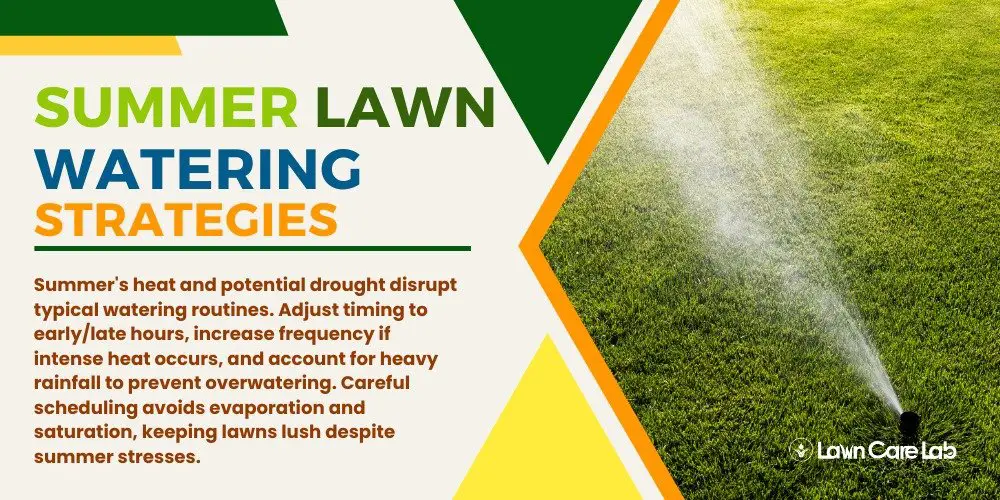
Transitioning from spring to summer necessitates a shift in your lawn watering strategies to accommodate increased heat and potential periods of drought.
Our objective is to sustain a lush, thriving lawn throughout the peak of the year’s heat.
Understanding Summer Lawn Watering Challenges
High summer temperatures and scarce rainfall can certainly disrupt your lawn watering routine, right? You’re not alone in facing this issue. Recognizing these challenges is the first step to ensuring a vibrant, healthy lawn.
Here are the three primary hurdles you might encounter:
- Evaporation: The searing summer heat accelerates evaporation, minimizing the amount of water your lawn can retain.
- Drought: Lengthy spells without rain can leave your lawn thirsty and susceptible to harm.
- Water restrictions: In certain regions, water consumption might be regulated during summer, affecting your regular watering schedule.
Being aware of these obstacles allows you to adapt and plan effectively. Stay with us as we explore the construction of a summer watering timetable meticulously designed to surmount these impediments.
Developing a Summer Watering Schedule
Adjust your summer irrigation routine to manage hotter temperatures. Fine-tune watering intervals and consider precipitation levels to avoid overwatering.
Here, we’ll outline pragmatic steps in creating a summer watering schedule uniquely suited to your lawn’s requirements.
Adjusting Watering Times for High Temperatures
In the face of soaring temperatures, it becomes essential to recalibrate your watering schedule to maintain the vitality and hydration of your lawn. Here are some expert tips:
- Opt for early morning or late evening watering to minimize evaporation.
- Augment watering frequency during periods of intense heat.
- Keep a keen eye on your lawn’s condition; parched patches indicate a need for more water.
With consistent vigilance and necessary adjustments, you can ensure a verdant and thriving lawn.
Accounting for Rainfall in Watering Schedule
During heavy rainfall, modify your watering schedule to prevent over-saturation of your landscape. Decrease or omit additional watering as rain provides ample hydration for your lawn.
Monitor local weather and avoid excessive watering to protect plants from disease and promote healthy root growth.
Autumn Lawn Watering Adjustments

As autumn sets in, it becomes crucial to recalibrate your lawn watering habits. The cooling weather signals your yard to reduce its water consumption in preparation for winter dormancy.
Let’s explore the creation of an efficient fall watering regimen and the best methods to transition your lawn for this seasonal shift.
Preparing Your Lawn for Fall
As the autumnal season draws near, modifying your lawn care regimen to brace for the winter’s chillier months is essential. This preparation is pivotal in maintaining your lawn’s health and vibrancy throughout the frosty winter season.
Here are three key steps to consider:
- Modulate the watering routine: The arrival of fall brings cooler temperatures, requiring less watering for your lawn. Gradually decrease watering to prevent oversaturation.
- Prioritize effective drainage: Check your lawn for improper drainage. Puddles or moist areas can harm your lawn in winter.
- Anticipate the inaugural frost: Ensure your lawn has proper drainage before the first frost to prevent damage and aid recovery in the spring.
Crafting an Autumn Watering Schedule
In autumn, adjust your irrigation routines to align with the changing climate. Water less frequently but deeper to prepare your turf for the upcoming chill.
Seasonal rainfall, timing, and frequency are all significant factors in devising an effective autumn watering schedule.
Timing and Frequency of Watering in Fall
Modifying your lawn watering regimen to accommodate your regional climate and specific grass species is essential as fall arrives. Here are some expert recommendations:
- Diminish the frequency of watering compared to the summer months.
- Always ensure that watering takes place in the morning.
- Alter your watering routine depending on the amount of rainfall your region receives.
Overwatering can induce diseases and lead to root complications. By making these key seasonal alterations, you’re safeguarding the vitality and well-being of your lawn.
Preparing for Seasonal Rainfall
As the rainy season approaches, it’s crucial to adapt your watering routines to prevent the oversaturation of your turf. Proper drainage is key in warding off waterlogging and the potential harm to roots.
Adapting watering schedules during heavy rains and closely observing soil moisture levels is advisable. This equilibrium will help maintain a healthy and lush lawn.
Now, let’s shift our focus to winter lawn watering strategies, another vital component of comprehensive, year-round lawn maintenance.
Winter Lawn Watering Practices

Now that you’ve transitioned your lawn care to accommodate the autumn season, it’s crucial to manage the intricacies of winter maintenance adeptly.
The cold season shouldn’t put your lawn care practices into hibernation; adequate watering during winter remains vital.
Let’s address your winter watering queries and assist you in formulating an effective watering regimen for the winter months.
Addressing Winter Watering Concerns
Winter necessitates a strategic shift in your lawn care regimen to counteract potential dryness. This chilly season brings distinct complications, mandating meticulous preparation.
Here are three essential strategies to maintain your lawn’s vibrancy:
- Hydrate before the first freeze: Administering water before the first frost is crucial for maintaining lawn moisture during winter.
- Promote efficient drainage: Sufficient drainage is crucial in preventing waterlogging, which can harm your lawn. Check your soil’s drainage before winter.
- Keep abreast of meteorological fluctuations: Vigilantly track weather patterns. Sparse rainfall might necessitate sporadic lawn watering.
Structuring a Winter Watering Schedule
Creating an effective winter watering routine requires a thoughtful balance. Overwatering can be harmful, yet neglecting to water your lawn adequately may result in winter drought.
When and How Often to Water in Winter
To maintain the vitality of your lawn during winter, it’s imperative to modify your watering regimen accordingly.
Here are three essential guidelines:
- Opt to irrigate your lawn around midday when temperatures rise above freezing.
- Modify the watering frequency relative to your specific regional weather patterns.
- Take into account the unique water needs of the grass variety present in your lawn.
Combating Winter Drought Conditions
Ensuring your lawn remains vibrant requires deep but sparse watering. This approach moisturizes your grass even amidst the most severe winter droughts.
Modifying your watering routine to suit these circumstances is a savvy, informed decision that maintains your lawn’s aesthetic appeal and emphasizes safety.
Tools and Techniques for Effective Lawn Watering Techniques
Selecting the appropriate apparatus and strategies for hydrating your lawn can significantly enhance its vitality and aesthetics. It goes beyond the mere act of unleashing a hose; judicious watering necessitates meticulous planning and superior gear.
- Irrigation Systems: Consider installing sprinklers or drip irrigation for healthier grass growth.
- Hydration Strategies: Optimal times to hydrate your lawn are early dawn or late dusk to mitigate evaporation. Avoid excessive watering; lawns generally require approximately 1 inch of water weekly.
- Rain Gauges: These invaluable instruments allow you to quantify rainfall to modulate your watering routine accordingly.
Observe that safety remains paramount. Always deactivate your irrigation system during rain to avert overhydration and potential inundation.
- How to Create a Lawn Care Schedule for Southern Climates - October 30, 2024
- How to Use Compost Tea to Boost Lawn Growth and Soil Health - October 23, 2024
- The Best Grasses for Saltwater-Exposed Lawns: Coastal Lawn Care - October 17, 2024

